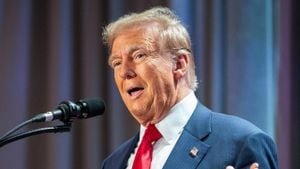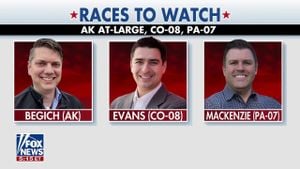Following the recent arrest of Ismael "El Mayo" Zambada, the legendary leader of the Sinaloa cartel, Mexico has been gripped by unprecedented violence, indicating how deeply intertwined organized crime and governance have become within the region. Since Zambada’s detainment, over 400 people have lost their lives to cartel violence—a staggering increase compared to the same time last year, raising questions about the effectiveness of the government's approach to tackling drug crimes.
The situation worsened drastically following Zambada’s capture on July 25, when he was flown to the U.S. to face charges involving drug trafficking, firearms, and money laundering. The arrest was touted by many—including U.S. Ambassador Ken Salazar—as a significant victory against narcotics. "We should be celebrating what happened in Sinaloa," he commented. Yet, behind the walls of the cartel, the fallout painted quite another picture.
Far from bringing stability, Zambada’s removal has led to fierce infighting among competing factions as groups vie for control over drug trafficking routes and territories. His absence has created what many are calling a power vacuum, which has intensified conflict, particularly among rival factions within the Sinaloa cartel itself.
According to analyst Carlos Pérez Ricart, Zambada represented more than just criminal influence; he was seen as stabilizing force within Sinaloa. The chaotic aftermath of his arrest has made towns across the state like Culiacán increasingly dangerous, effectively transforming them from vibrant communities to ghost towns, where residents have been forced indoors to escape the crossfire. “We never imagined we’d live this war,” said Guadalupe Gress, whose family runs a local store. “The schools are closed, people can’t work - and where’s the government?”
Restaurants and businesses are also suffering. Chef Miguel Taniyama, who once had three thriving restaurants, has shut down two due to the resultant insecurity. He pointed out, “The person who kept the order was El Mayo. Security should have been provided by the government. They didn’t do it.”
With rising tension, local authorities have dispatched thousands of troops to restore order, but many residents remain skeptical. Despite military presence, fears loom large over daily life as violent clashes break out. Gunmen have taken to the streets, blocking roads with burning barricades and heightening tensions. Symptoms of this lawlessness can be seen across media reports detailing gunfire attacks not only on rival gangs but on law enforcement, as well as public property.
Remarkably, the chaos also stirred up unsolicited interest from local law enforcement. Under increasing scrutiny, the police force has faced accusations of corruption and inefficacy, leading many community members to question whom to trust. Observers argue the problem goes beyond mere violence; it encapsulates the deteriorated trust between the populace and state apparatus.
While the U.S. and Mexican authorities have long embraced what they term the “kingpin strategy,” this approach has elicited mixed responses. It targets cartel leaders for arrest and extradition, assuming their removal will spur dismantling of crime organizations. But the surge of violence following Zambada's apprehension casts doubt on this theory. Benjamin T. Smith, historian and author, points to statistical indications supporting the idea: removing key figures frequently ignites struggles for dominance among other cartel members, leading to spikes in violence. "The U.S. government must have known this was going to happen," he remarked.
The conflict has also had broader repercussions, reverberations echoing within international borders, particularly the U.S. Faced with drug trafficking from Mexico, U.S. officials are grappling with the consequences, including surges of fentanyl-related overdose deaths, which have dramatically impacted suburban and urban communities alike. Fentanyl, often referred to as the leading killer for Americans aged 18 to 49, has triggered harrowing consequences for everyday families dealing with the aftermath.
The U.S. Drug Enforcement Administration (DEA) has firmly associated major narcotics distributors, such as the Sinaloa cartel, with the rising fentanyl crisis, crediting their operations with flooding American streets with the drug. The agency has labeled the cartel’s activities as part of the “single deadliest drug threat” the country has ever encountered. A recent indictment described the methods used—aggressive and calculated—to expand their territories within the drug trade.
With the situation deteriorated and mistrust deepening, residents watch as rival factions strategically position themselves across the region, anticipating imminent confrontation. Most citizens want sanctuary, but the reality of their precarious existence stands starkly at odds with the peaceful lives they once led. Numerous reports describe how daily routines have irrevocably changed; many fear for their safety.



